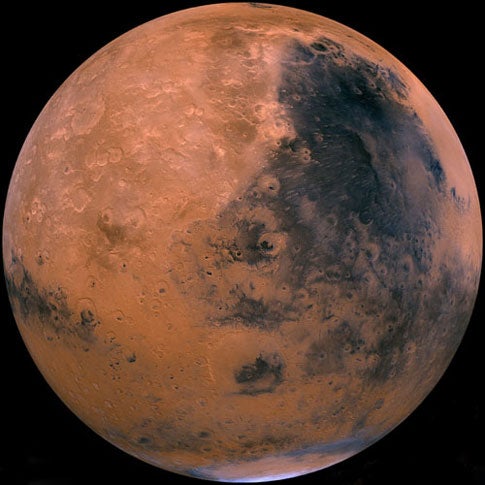Mars had significantly warmer weather in its recent past than previously thought, according to new research led by a scientist from the United Kingdom. The research, funded by the Science and Technology Facilities Council (STFC) in the United Kingdom, is good news in our quest for life on Mars. The shorter the time period since the last warm weather on the planet, the better the chance that organisms that may have lived in warmer times are still alive under the planet’s surface.
Matthew Balme from The Open University in the United Kingdom made the new discovery by studying detailed images of equatorial landforms that formed by melting of ice-rich soils. His work indicates that the martian surface experienced “freeze thaw” cycles as recently as 2 million years ago, and that Mars has not been locked in permafrost conditions for billions of years as had been thought previously.
The high-resolution images, which show a variety of interesting landforms, were taken with NASA’s High Resolution Imaging Science Experiment (HiRISE) onboard the Mars Reconnaissance Orbiter (MRO).
“The features of this terrain were previously interpreted to be the result of volcanic processes,” Balme said. “The amazingly detailed images from HiRISE show that the features are caused instead by the expansion and contraction of ice and by thawing of ice-rich ground. This all suggests a very different climate to what we see today.”
All of the landforms observed are in an outflow channel, thought to have been active as recently as 2 million to 8 million years ago. Because the landforms exist within, and cut across, the pre-existing features of the channel, this suggests that they, too, were created within this timeframe.
The pictures show polygonally patterned surfaces, branched channels, blocky debris, and mound/cone structures. All of these features are similar to landforms on Earth typical of areas where permafrost terrain is melting.
“These observations demonstrate that there was not only ice near the martian equator in the last few million years, but also that the ice melted to form liquid water and then refroze,” Balme said. “And this probably happened for many cycles. Given that liquid water seems to be essential for life, these kinds of environments could be a great place to look for evidence of past life on Mars.”
“This new research has revealed more about Mars and provided fascinating evidence of geological process similar to Earth,” said Keith Mason, CEO of the Science and Technology Facilities Council (STFC). “The history of our neighboring planet, and the question of whether it has ever sustained life, has long fascinated man. Understanding current processes on the surface of Mars and the past and present role of climate, improves our knowledge of the planet’s history and the chances of one day detecting evidence for past or present life. Scientists are involved in a number of different Mars studies, which are helping to paint a full picture of this mysterious planet.”










